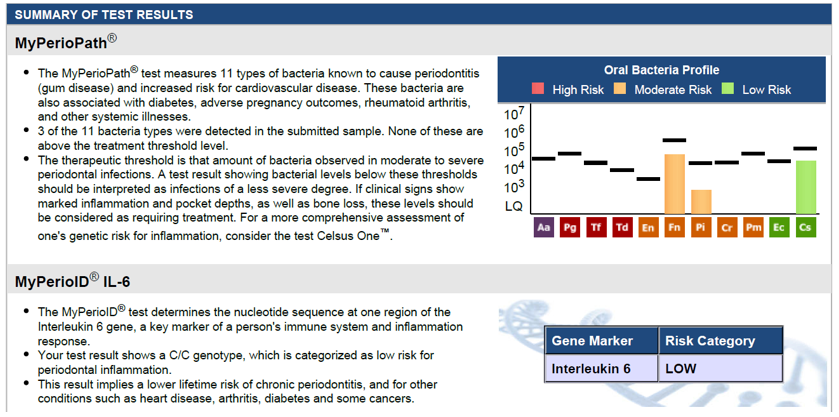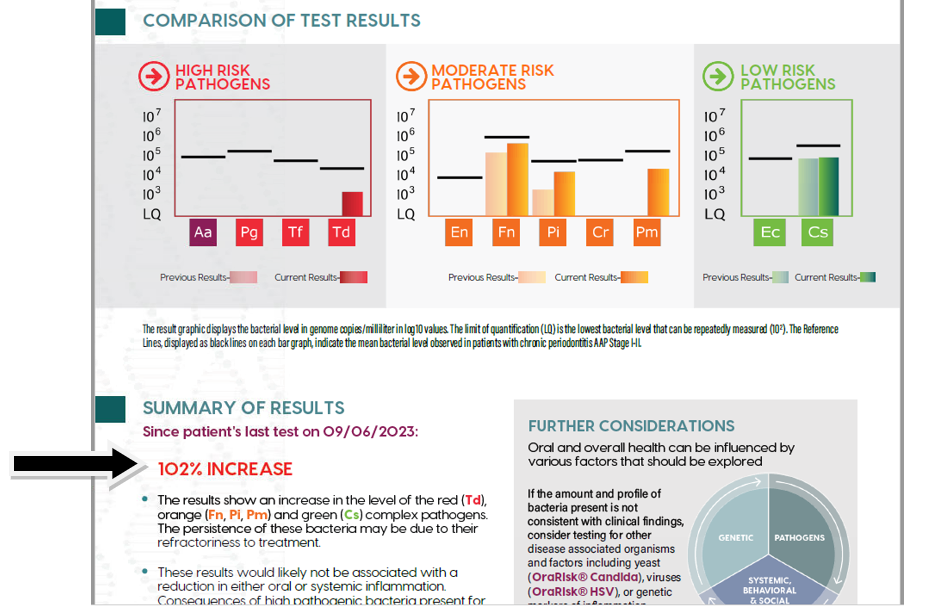In the world of healthcare, understanding the root cause of health issues is paramount to providing effective treatment. This principle was put to the test in a fascinating case that highlighted the importance of considering both clinical and personal factors in patient care. The case involved an unexpected 102% increase in bacterial load within a patient’s mouth, despite having undergone scaling, irrigation, and decontamination—a procedural-set known to significantly reduce bacterial load. This anomaly prompted a deep dive into the phenomenon of horizontal transmission and its impact on oral health.
The patient in question had been monitored using Salivary Diagnostics to evaluate the bacterial load for 11 pathogenic bacteria related to periodontal disease and a genetic marker through IL-6 to evaluate the patient’s natural response to inflammatory disease.
Initially, an Alert 2™ report indicated a low bacterial load, setting a positive outlook for post-scaling recovery. However, for the follow-up report, the MyPerioPath® revealed a baffling 102% increase in bacterial load three months post-scaling. This was a curveball no one expected.
Alert 2 Before Scaling:

MyPerioPath Three-Months After Scaling:

By asking detailed, probing questions about the patient’s lifestyle and recent changes, a crucial piece of information came to light: the patient had started dating someone new. This revelation steered the case outlook towards the concept of horizontal transmission, the process by which bacteria are transferred between individuals, potentially altering the oral microbiome.
Horizontal transmission can significantly impact an individual’s oral flora, introducing new pathogenic bacteria that may not have been present previously. In intimate relationships, activities such as kissing, sharing utensils, or even close conversations can facilitate the transfer of bacteria between mouths. This case underscored the importance of considering personal relationships and behaviors in diagnosing and treating oral health anomalies.
Recognizing the influence of the patient’s new relationship on their oral health, our team crafted a tailored treatment plan. The approach went beyond traditional methods, incorporating counseling on the importance of oral hygiene not just for the patient but for their partner as well. The patient was motivated to discuss the situation with their partner, emphasizing the significance of oral health and its impact on the individual as well as the family’s overall well-being.
Encouraged by the dental team’s support and understanding, the patient successfully persuaded their partner to undergo assessment and scheduled an appointment for a New Patient Exam. This collaborative effort not only addressed the immediate issue of the increased bacterial load for our patient but also set both individuals on a path to better oral health practices.
Lessons Learned
This case serves as a compelling reminder of the complexities involved in dental care and the importance of a comprehensive approach. By considering factors beyond the clinical—such as personal relationships and horizontal transmission—dental professionals can uncover hidden causes of oral health issues. The success of this case lies in the combination of investigative due diligence, patient education, and a comprehensive treatment strategy that accounted for the interconnectedness of people’s lives and their health. Without addressing all these factors, our practice would have been unable to “tip the scale” in favor of our patient’s oral health.
In the end, the dental team’s ability to adapt and consider all aspects of the patient’s life not only solved a perplexing case but also reinforced the vital role of dentistry in promoting overall health. Through open communication, collaboration, and a deep understanding of the dynamics of horizontal transmission, dental professionals can continue to make significant strides in both patient and family overall healthcare.
- Revolutionizing Periodontal Disease Screening and Treatment with OFC and Alert 2™ Diagnostics - October 25, 2024
- Dr. Benavides: “Did We Overtreat: The Value of Proactive Intervention for the Periodontal Patient.” - August 23, 2024
- A Dental Detective Story – When a 102% Surge in Bacterial Load After Scaling Unveils a Horizontal Transmission Tale - April 5, 2024


